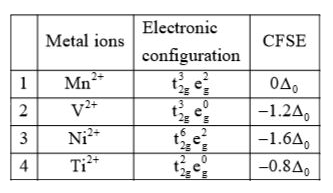Given that the energy of the photons of different colours decreases in the order of VIBGYOR (Violet > Indigo > Blue > Green > Yellow > Red ) and that if complex absorbs a photon of low energy then it shows colour of high energy photon. If an ion , M2+, forms the complexes [M(H2O)6]2+,[MBr6]4−,and[M(en)3]2+. The colours of the complexes, though not necessarily in order, are green, red, and blue. Match the complexes with the appropriate colour. ( Do not use the table of complementry colours for this question )
Green, blue and red
Blue, and greenn
Green, red and blue
Red, blue and green
The correct Answer is:D
To solve the problem, we will analyze the complexes formed by the ion M2+ and determine their colors based on the ligand strength and the energy of the photons they absorb.
1. Identify the Ligands and Their Strengths:
- The ligands involved are:
- H2O (water)
- Br− (bromide)
- en (ethylenediamine)
- The order of ligand strength (from strongest to weakest) is:
- en>H2O>Br−
2. Understand the Relationship Between Ligand Strength and Splitting Energy:
- In octahedral complexes, the splitting energy (Δ) is directly proportional to the strength of the ligand. Stronger ligands cause greater splitting of the d-orbitals.
- Therefore, for our ligands:
- Δen>ΔH2O>ΔBr
3. Determine the Colors Based on Absorption:
- The color observed by a complex is the complementary color of the light it absorbs. If a complex absorbs lower energy light, it will appear as a higher energy color.
- The order of photon energy (from high to low) is: Violet > Indigo > Blue > Green > Yellow > Red.
- Thus, the corresponding colors of the complexes will be:
- For en: Absorbs high energy (violet/blue), appears red (low energy).
- For H2O: Absorbs intermediate energy (green), appears green.
- For Br−: Absorbs low energy (red), appears blue (high energy).
4. Match the Complexes with Their Colors:
- (M(H2O)6)2+ will show green color (intermediate energy absorption).
- (MBr6)4− will show blue color (absorbs red).
- (M(en)3)2+ will show red color (absorbs violet/blue).
Final Matching:
- (M(H2O)6)2+ → Green
- (MBr6)4− → Blue
- (M(en)3)2+ → Red
- The ligands involved are:
- H2O (water)
- Br− (bromide)
- en (ethylenediamine)
- The order of ligand strength (from strongest to weakest) is:
- en>H2O>Br−
- In octahedral complexes, the splitting energy (Δ) is directly proportional to the strength of the ligand. Stronger ligands cause greater splitting of the d-orbitals.
- Therefore, for our ligands:
- Δen>ΔH2O>ΔBr
- The color observed by a complex is the complementary color of the light it absorbs. If a complex absorbs lower energy light, it will appear as a higher energy color.
- The order of photon energy (from high to low) is: Violet > Indigo > Blue > Green > Yellow > Red.
- Thus, the corresponding colors of the complexes will be:
- For en: Absorbs high energy (violet/blue), appears red (low energy).
- For H2O: Absorbs intermediate energy (green), appears green.
- For Br−: Absorbs low energy (red), appears blue (high energy).
- (M(H2O)6)2+ will show green color (intermediate energy absorption).
- (MBr6)4− will show blue color (absorbs red).
- (M(en)3)2+ will show red color (absorbs violet/blue).
- (M(H2O)6)2+ → Green
- (MBr6)4− → Blue
- (M(en)3)2+ → Red
Topper's Solved these Questions
- CO-ORDINATION COMPOUNDSBOOK - VK JAISWAL ENGLISHCHAPTER - CO-ORDINATION COMPOUNDSEXERCISE - SUBJECTIVE PROBLEMS
42 Videos
- CHEMICAL BONDING (BASIC)BOOK - VK JAISWAL ENGLISHCHAPTER - CHEMICAL BONDING (BASIC)EXERCISE - SUBJECTIVE PROBLEMS
54 Videos
- d-BLOCK ELEMENTSBOOK - VK JAISWAL ENGLISHCHAPTER - d-BLOCK ELEMENTSEXERCISE - ASSERTION-REASON TYPE QUESTIONS
32 Videos
Similar Questions
Knowledge Check
In group 14 of the periodic table, the oxidising power of tetravalent species decreases in the order
a. Ge>Pb>Sn
b. Ge>Sn>Pb
c. Pb>Ge>Sn
d. Pb>Sn>GeAGe>Pb>SnBGe>Sn>PbCPb>Ge>SnDPb>Sn>Ge
Two complexes [Cr(H2O6)6]Cl3 and [Cr(NH3)6]Cl3 (B) are violet and yellow coloured, respectively. The incorrect statement regarding them is :
View SolutionCorystal field splitting energy (CFSE) for the complex [Cr(H2O)6]2+ is when (Δ<P) .
View SolutionSelect incorrect match for [M(H2O)6]2+ complex.

View SolutionThe radiant energy is emitted or absorbed continuously in the form of photons.
View SolutionAssertion: Concentrated aqueous solution of CuCl2 is green in colour.
Reason : The solution contains two complex ions i.e., [Cu(H2O)4]2+and[CuCl4]2− in equilibrium.
View SolutionA gas absorbs a photon of 310nm and emits three photons.
If energy of emitted photons is in the ratio 1:2:1 then select correct statement(s) :
View SolutionThe number of photons of light of ¯v=4.5×106m−1 necessary to provide 2 J of energy are:
View Solution
